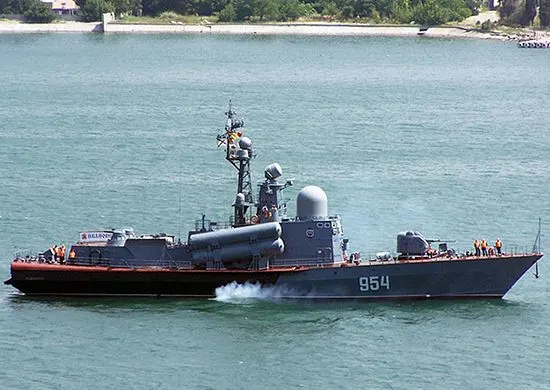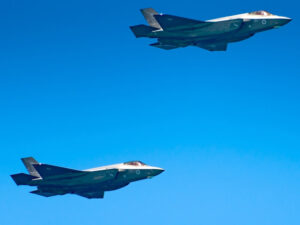The apparent sinking of the Russian missile corvette Ivanovets by a swarm of Ukrainian surface drones has suggested to some that (again) the traditional surface warship is obsolete.
Dramatic, detailed video of the attack from the Ukrainian suicide drones suggests the Russian ship was hopelessly outmaneuvered by the drones, offered little resistance and was quickly dispatched, with the end of the video showing the sinking ship’s bow projecting about the water as she sinks.
No doubt, it was a solid victory for Ukrainian forces. That said, when the engagement is analyzed, it’s a lot more about Russian failures rather than uncrewed drone success.
Missile corvettes are a flotilla combatant best employed in numbers and not as individual units where their small size and small number of self-defense weapons makes them vulnerable to attack. The Ivanovets video was filmed at night, and parts of the ship are not fully visible, but one wonders why the Russian ship was not able to engage the drones at greater range with her 76mm gun and 30mm close in weapon system guns. Didn’t the Ivanovets have any additional lookouts? Were crew-served weapons closed up for this operation, which would run counter to a common practice for other navies expecting a small craft (crewed or uncrewed) threat?
Bigger vs. Smaller Ships
Ivanovets was a small warship already, but she was apparently overwhelmed by a flotilla of even smaller uncrewed combatants. This is not a new phenomenon, and the older ship’s age and lack of readiness can play a role in making such a vessel vulnerable to flotilla attack. A good historical example of this was the May 1945 sinking of the Japanese heavy cruiser Haguro by the British Royal Navy’s five-ship, 26th destroyer flotilla in Operation Dukedom.
Haguro was used in the waning days of World War II as a supply vessel serving isolated Japanese garrisons in the Andaman Islands from her base in Singapore. Haguro was in poor condition when she sailed. The guns from one of her turrets, damaged in an earlier battle had been removed from the ship, weakening her firepower. She had recently run aground and been damaged. Finally, in order to make more room onboard for supplies, her torpedo tubes were removed and some of her main gun ammo was also offloaded. Haguro was not ready for battle.
It has been reported that Ivanovets sank after being hit by six drones. She, too, was likely in poor material condition due to age (she was commissioned in 1989) and the reported poor readiness of other Black Sea ships such as the cruiser Moskva, whose anti-missile combat system and close-in, self defense weapons were reported inoperative at the time of her sinking. Like Haguro, Ivanovets appears to have been surrounded by attackers and damaged first astern, leaving her unable to maneuver and an easy target. Ivanovets also appears alone and unsupported by other Russian ships in her five-ship flotilla.
Probable Russian failures
Besides general material condition and readiness, one wonders why Ivanovets’ surface search radars did not earlier detect the incoming drone craft. Since the days of the 1980’s tanker war, the U.S. and other Western navies have employed additional lookouts and crew-served weapons around the ship to identify small targets, especially wooden ships that often do not “paint” well on radar until they are very close, and mines.
It does not appear from the video that Ivanovets has any additional lookouts or crew-served weapon teams posted. The ship’s 30mm close-in weapons system appears to engage the drones, but without the rate and mass of firepower credited to those weapons. The 30mm guns also cease fire when attacking drones are directly astern of the ship, suggesting the gun is masked from firing dead astern.
The Ivanovets was also operating in a coastal estuary named Lake Donuzlav, a body of water 19 miles by five miles. The Russian ship may have been under the assumption that there was an insignificant threat inside an interior Crimean space far from the battlefronts. Donuzlav is also the location of a former Ukrainian naval base captured by the Russians in their 2014 annexation of Crimea, so its not surprising that the Ukrainians knew how to operate there.
How the U.S. Navy can improve
There are a number of lessons for the U.S. Navy from the sinking of Ivanovets. Despite nearly 40 years of preparing to face small boat swarms in the Persian Gulf and other locations, the U.S. Navy can still improve its tactics, techniques and procedures to avoid having ships meet the same fate:
- The battle against uncrewed drones can be where you least expect it, so be prepared accordingly, even if in protected waters.
- Deploy crewed or uncrewed aircraft to better view the battlespace. Aviation assets of all types, including small drones, extend a ship’s range of action and can buy time to better defend against drone attacks.
- Readiness matters. Ivanovets was an older ship, and sporadic fire from her 30mm close-in weapon system suggested these systems were not fully functional or ready for combat. Maximum readiness of all ship systems is essential to evade and defend against drone attacks.
- Additional crew-served weapons can help. A burst of .50 caliber machine gun fire won’t deter a drone the way it might deter a manned speedboat attack, but all the additional firepower a ship can muster could be the difference between a successful defense and sinking. Many installed weapon systems have a minimum range and if drones penetrate inside that there are few other options for self-defense.
- Vigilance is essential. Deploy additional lookouts, close up additional watch stations and keep people ready. Every additional set of eyes on the situation could make a difference in detecting a drone attack before it gets too close, as appears to have been the case with the
During the American Civil War Union sailors feared the deployment of Confederate “infernal machines” such as semisubmersible spar torpedo craft, mines and of course submarines like the Hunley that sank the USS Housatonic. Today’s uncrewed drones are perhaps the new infernal machines of the 21st century and the waterborne counterparts of monsters from Philip K Dick novels. Still, there are ways to counter such attacks and many lessons to be learned from battles like the sinking of Ivanovets.







